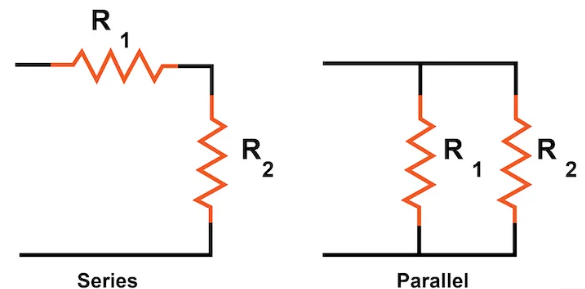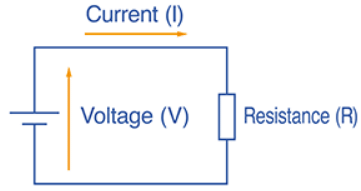Class 7 Exam > Class 7 Notes > Year 7 Physics (Cambridge) > Currents in series circuits
Currents in series circuits | Year 7 Physics (Cambridge) - Class 7 PDF Download
| Table of contents |

|
| Electrical Circuits: Series and Parallel |

|
| Voltage and Current |

|
| Resistance in Circuits |

|
| Calculating Total Resistance |

|
Electrical Circuits: Series and Parallel
Series Circuit
- Components are connected end to end in a single loop.
- Current flows through each component sequentially.
- Example: A circuit with a cell and bulbs connected in a single line.
Parallel Circuit
- Components are connected side by side.
- Current divides, with some flowing through each component.
- Example: A circuit with a cell and bulbs connected in separate branches.

Voltage and Current
Voltage
- Voltage is the electrical push provided by the battery.
- Measured in volts (V), which is energy (joules) per unit of charge (coulombs).
- Example: Each cell in a series adds 1.5V, so four cells provide 6V.
Current
- Current is the flow of electrons through a circuit.
- Measured in amperes (A), or amps, which is charge (coulombs) per second.
- Example: Current through a lamp is 0.20A; through a resistor is 0.10A.
Resistance in Circuits
Resistance
- Resistance opposes the flow of current.
- Measured in ohms (Ω), symbolized by the Greek letter omega (Ω).
- Example: Higher resistance means more difficulty for current to flow.
Series Circuit Characteristics
- Voltage Distribution: Total voltage is shared among components.
- Current: Same current flows through each component.
- Total Resistance: Sum of individual resistances.

Parallel Circuit Characteristics
- Voltage Distribution: Each component gets the same voltage.
- Current: Total current is the sum of currents through each component.
- Total Resistance: Less than the smallest individual resistance.
Calculating Total Resistance
- Series Circuit:
Total resistance
- Parallel Circuit:
Formula for reciprocal resistance:
Question for Currents in series circuitsTry yourself: What happens to the total resistance in a series circuit when more resistors are added?View Solution
Conclusion
Understanding series and parallel circuits is fundamental to understanding how electricity behaves in different configurations. Series circuits maintain a single path for current flow, while parallel circuits allow current to divide across multiple paths. Voltage, current, and resistance are essential concepts that govern how components behave in electrical circuits. These principles are applied practically to analyze and design circuits for various applications.
The document Currents in series circuits | Year 7 Physics (Cambridge) - Class 7 is a part of the Class 7 Course Year 7 Physics (Cambridge).
All you need of Class 7 at this link: Class 7
|
14 videos|31 docs|9 tests
|
FAQs on Currents in series circuits - Year 7 Physics (Cambridge) - Class 7
| 1. What are the differences between series and parallel circuits in terms of current flow? |  |
Ans. In a series circuit, the current has only one path to flow through all the components, while in a parallel circuit, the current has multiple paths to flow through different branches.
| 2. How does the total resistance differ in series and parallel circuits? |  |
Ans. In a series circuit, the total resistance is the sum of the individual resistances, whereas in a parallel circuit, the total resistance is less than the smallest individual resistance.
| 3. What happens to the brightness of light bulbs in a series circuit if one bulb goes out? |  |
Ans. If one light bulb goes out in a series circuit, all the other bulbs will also go out because the circuit is broken and no current can flow.
| 4. How does the voltage drop across components differ in series and parallel circuits? |  |
Ans. In a series circuit, the voltage is divided among the components, with each component receiving a fraction of the total voltage. In a parallel circuit, each component receives the full voltage.
| 5. Why are parallel circuits commonly used in homes for electrical wiring? |  |
Ans. Parallel circuits are used in homes for electrical wiring because if one appliance or light fixture fails, it will not affect the operation of other appliances or fixtures due to the independent paths for current flow in parallel circuits.
Related Searches




















